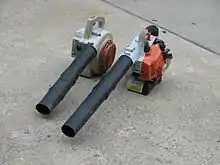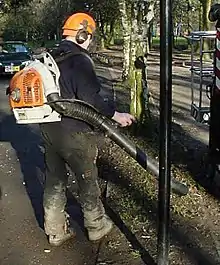Leaf blower
A leaf blower, commonly known as a blower, is a gardening tool that propels air out of a nozzle to move debris such as leaves and grass cuttings. Leaf blowers are powered by electric or gasoline motors. Gasoline models have traditionally been two-stroke engines, but four-stroke engines were recently introduced to partially address air pollution concerns. Leaf blowers are typically self-contained handheld units, or backpack mounted units with a handheld wand. The latter is more ergonomic for prolonged use. Larger units may rest on wheels and even use a motor for propulsion.[1] These are sometimes called "walk behind leaf blowers" because they must be pushed by hand to be operated.

Some units, called blower vacs, can also suck in leaves and small twigs via a vacuum, and shred them into a bag.
Overview

Drought conditions in California facilitated acceptance of the leaf blower as the use of water for many garden clean-up tasks was prohibited. Leaf blowers also save time compared to a broom.[2] By 1990, annual sales were over 800,000 in the U.S., and the tool had become a ubiquitous gardening implement.
Other functions beyond the simple use of garden maintenance have been demonstrated by Richard Hammond on the Brainiac television series, in which a man sized hovercraft was constructed from a leaf blower. Being both portable and able to generate wind speeds of between 140–270 miles per hour (63–121 m/s) and air volumes of 14 m3 per minute, the leaf blower has many potential uses in amateur construction projects.
The origin of the leaf blower originated in 1947 as a backpack fogger apparatus, invented by Japanese-based Kyoritsu Noki Company. Kyoritsu followed that design with a backpack/blower/misting machine in 1955. in 1968, Kyoritsu applied for patent on a backpack blower mister design, and in 1972 established themselves in the United States as Kioritz Corporation of America, and is said to have invented the first leaf blower in 1977. The company changed their name to Echo in 1978.
Amongst such rival manufacturers as Stihl, Weed Eater, and Husqvarna, Echo saw the sales of leaf blowers in the 1970s explode. It is estimated that the sale of leaf blowers in the U.S., had exceeded 1 million units by 1989.
Environmental and occupational impact

Emissions from gasoline-powered grounds-keeping equipment in general are a source of air pollution[3] and more immediately (when powered by internal combustion engines, rather than by electricity), noise pollution. In the United States, US emission standards prescribe maximum emissions from small engines. The two-stroke engines used in most leaf blowers operate by mixing gasoline with oil, and a third of this mixture is not burned, but is emitted as an aerosol exhaust. These pollutants have been linked to cancer, heart disease, and asthma.[4] A 2011 study found that the amount of NMHC pollutants emitted by a leaf blower operated for 30 minutes is comparable to the amount emitted by a Ford F-150 pickup truck driving from Texas to Alaska.[5]
In addition to the adverse health effects of carbon monoxide, nitrogen oxides, hydrocarbons, and particulates generated in the exhaust gas of the gasoline-powered engines, leaf blowers pose problems related to dust raised by the powerful flow of air. Dust clouds caused by leaf blowers contain potentially harmful substances such as pesticides, mold, and animal fecal matter that may cause irritation, allergies, and disease.
Noise pollution is also a concern with leaf blowers, as they can emit noise levels above those required to cause hearing loss to both the operator and those nearby.
Leaf blowers also present an occupational hearing hazard to the nearly 1 million people who work in lawn service and ground-keeping.[6] A recent study assessed the occupational noise exposure among groundskeepers at several North Carolina public universities and found noise levels from leaf blowers averaging 89 decibels (A-weighted) and maximum sound pressure levels reaching 106 dB(A), both far exceeding the National Institute for Occupational Safety and Health (NIOSH) Recommended Exposure Limit of 85 dB(A)[7]
Bans
Soon after the leaf blower was introduced into the U.S., its use was banned in two California cities, Carmel-by-the-Sea in 1975 and Beverly Hills in 1978, as a noise nuisance. There are currently twenty California cities that have banned leaf blowers, sometimes only within residential neighborhoods and usually targeting gasoline-powered equipment. Another 80 cities have ordinances on the books restricting either usage or noise level or both.[8]
Quieter solutions
To meet the 1995 California regulations for noise and air pollution, leaf blower manufacturers modified the current engine designs to comply, however, 1999 regulations were far more stringent, forcing the engineering of a quieter, more compliant 2-stroke engine design. While leaf blowers were becoming more tolerable in U.S. suburban neighborhoods, many communities had by now in fact, banned their use. In the mid 2000s and to further answer critics, manufacturers once again evolved the leaf blower, with the use of NICad (nickel-cadmium) powered tool design to create the first cordless leaf blower. The new NiCad battery-powered leaf blower designs, were to further improved by way of the more powerful, and longer run time lithium-ion batteries, which incorporate most cordless leaf blowers marketed today. Cordless leaf blowers today operate with zero emissions, and operate at an estimated 70% reduction, compared to the noise level produced by its predecessors.
See also
References
- "Leaf blowers". Consumer Reports. Retrieved 29 May 2014.
- "CLCA Position On Leaf Blowers". California Landscape Contractors Association. Retrieved 29 May 2014.
- "Lawn Equipment | Improving Air Quality in Your Community | US EPA". Epa.gov. 2006-06-28. Archived from the original on 2009-04-28. Retrieved 2009-06-10.
- Bernhard, Adrienne (October 18, 2018). "Leaf Blowers Are Loud, Ugly and Dangerous". The Wall Street Journal. Archived from the original on October 21, 2018. Retrieved October 21, 2018.
- Kavanagh, Jason (December 5, 2011). "Emissions Test: Car vs. Truck vs. Leaf Blower". Edmunds. Archived from the original on August 31, 2017. Retrieved November 1, 2018.
- NIOSH (Jul 25, 2018). "Grounds for Change: Reducing Noise Exposure in Grounds Management Professionals". Retrieved Aug 15, 2018.
- Balanay, Jo Anne G.; Kearney, Gregory D.; Mannarino, Adam J. (2016-06-13). "Assessment of Occupational Noise Exposure among Groundskeepers in North Carolina Public Universities". Environmental Health Insights. 10: 83–92. doi:10.4137/EHI.S39682. ISSN 1178-6302. PMC 4909058. PMID 27330303.
- Leaf-blower regulations nationwide Consumer Reports magazine, September 2010.
External links
- "On Banning Leaf Blowers". The New York Times. 2017-03-17. Retrieved 2018-05-28.
- Cliff Weathers (2014). "Modern Pestilence: Leaf Blowers Generate Infuriating Noise, Toxic Gases and Hazardous Dust". Alternet. Retrieved 2018-05-28.
Blasting out air at hurricane-force speeds, leaf blowers spread allergens, toxins, pollutants and pathogens into the air we breathe
| Wikimedia Commons has media related to Leaf blowers. |